Potřebujeme váš souhlas k využití jednotlivých dat, aby se vám mimo jiné mohly ukazovat informace týkající se vašich zájmů. Souhlas udělíte kliknutím na tlačítko „OK“.
ASTM C1363-11
Standard Test Method for Thermal Performance of Building Materials and Envelope Assemblies by Means of a Hot Box Apparatus
Automaticky přeložený název:
Standardní zkušební metoda pro Tepelné chování stavebních materiálů a obálek shromáždění prostřednictvím Přístroje Hot Box
NORMA vydána dne 15.5.2011
Informace o normě:
Označení normy: ASTM C1363-11
Poznámka: NEPLATNÁ
Datum vydání normy: 15.5.2011
Kód zboží: NS-10861
Počet stran: 44
Přibližná hmotnost: 132 g (0.29 liber)
Země: Americká technická norma
Kategorie: Technické normy ASTM
Kategorie - podobné normy:
Anotace textu normy ASTM C1363-11 :
Keywords:
building assemblies, building materials, hot box, test method, thermal properties, thermal resistance: Building materials/applications, Flanking sound transmission/analysis, Heat transfer, Hot plate/box methods, Metering box heat loss, Metering wall transducer output, Thermal performance, Thermal resistance/resistivity, ICS Number Code 91.120.10 (Thermal insulation of buildings)
Doplňující informace
| Significance and Use | ||||||||||||||||||||||||||||||||||||||||
|
A need exists for accurate data on heat transfer through insulated structures at representative test conditions. The data are needed to judge compliance with specifications and regulations, for design guidance, for research evaluations of the effect of changes in materials or constructions, and for verification of, or use in, simulation models. Other ASTM standards such as Test Methods C177 and C518 provide data on homogeneous specimens bounded by temperature controlled flat impervious plates. The hot box test method is more suitable for providing such data for large building elements, usually of a built-up or composite nature, which are exposed to temperature-controlled air on both sides. For the results to be representative of a building construction, only representative sections shall be tested. The test specimen shall duplicate the framing geometry, material composition and installation practice, and orientation of construction (see Section 7). This test method does not establish test conditions, specimen configuration, or data acquisition details but leaves these choices to be made in a manner consistent with the specific application being considered. Data obtained by the use of this test method is representative of the specimen performance only for the conditions of the test. It is unlikely that the test conditions will exactly duplicate in-use conditions and the user of the test results must be cautioned of possible significant differences. For example, in some specimens, especially those containing empty cavities or cavities open to one surface, the overall resistance or transmittance will depend upon the temperature difference across the test specimen due to internal convection. Detailed heat flow analysis shall precede the use of the hot box apparatus for large, complex structures. A structure that contains cavity spaces between adjacent surfaces, for example, an attic section including a ceiling with sloping roof, may be difficult to test properly. Consideration must be given to the effects of specimen size, natural air movement, ventilation effects, radiative effects, and baffles at the guard/meter interface when designing the test specimen. For vertical specimens with air spaces that significantly affect thermal performance, the metering chamber dimension shall match the effective construction height. If this is not possible, horizontal convection barriers shall be installed inside the specimen air cavities at the metering chamber boundaries to prevent air exchange between the metering and guarding areas. The operator shall note in the report any use of convection barriers. The report shall contain a warning stating that the use of the barriers might modify the heat transfer through the system causing significant errors. For ceiling tests with low density insulations, the minimum lateral dimension of the specimen shall be at least several times the dimension of the expected convection cells. Since this test method is used to determine the total heat flow through the test area demarcated by the metering box, it is possible to determine the heat flow through a building element smaller than the test area, such as a window or representative area of a panel unit, if the parallel heat flow through the remaining surrounding area is independently determined. See Annex A8 for the general method. Discussion of all special conditions used during the test shall be included in the test report (see Section 13). |
||||||||||||||||||||||||||||||||||||||||
| 1. Scope | ||||||||||||||||||||||||||||||||||||||||
|
1.1 This test method establishes the principles for the design of a hot box apparatus and the minimum requirements for the determination of the steady state thermal performance of building assemblies when exposed to controlled laboratory conditions. This method is also used to measure the thermal performance of a building material at standardized test conditions such as those required in material Specifications C739, C764, C1224 and Practice C1373. 1.2 This test method is used for large homogeneous or non-homogeneous specimens. This test method applies to building structures or composite assemblies of building materials for which it is possible to build a representative specimen that fits the test apparatus. The dimensions of specimen projections or recesses are controlled by the design of the hot box apparatus. Some hot boxes are limited to planar or nearly planar specimens. However, larger hot boxes have been used to characterize projecting skylights and attic sections. See 3.2 for a definition of the test specimen and other terms specific to this method. Note 1—This test method replaces Test Methods C236, the Guarded Hot Box, and C976, the Calibrated Hot Box which have been withdrawn. Test apparatus designed and operated previously under Test Methods C236 and C976 will require slight modifications to the calibration and operational procedures to meet the requirements of Test Method C1363. 1.3 A properly designed and operated hot box apparatus is directly analogous to the Test Method C177 guarded hot plate for testing large specimens exposed to air induced temperature differences. The operation of a hot box apparatus requires a significant number of fundamental measurements of temperatures, areas and power. The equipment performing these measurements requires calibration to ensure that the data are accurate. During initial setup and periodic verification testing, each measurement system and sensor is calibrated against a standard traceable to a national standards laboratory. If the hot box apparatus has been designed, constructed and operated in the ideal manner, no further calibration or adjustment would be necessary. As such, the hot box is considered a primary method and the uncertainty of the result is analyzed by direct evaluation of the component measurement uncertainties of the instrumentation used in making the measurements. 1.3.1 In an ideal hotbox test of a homogenous material there is no temperature difference on either the warm or cold specimen faces to drive a flanking heat flow. In addition, there would be no temperature differences that would drive heat across the boundary of the metering chamber walls. However, experience has demonstrated that maintaining a perfect guard/metering chamber balance is not possible and small corrections are needed to accurately characterize all the heat flow paths from the metering chamber. To gain this final confidence in the test result, it is necessary to benchmark the overall result of the hot box apparatus by performing measurements on specimens having known heat transfer values and comparing those results to the expected values. 1.3.2 The benchmarking specimens are homogeneous panels whose thermal properties are uniform and predictable. These panels, or representative sections of the panels, have had their thermal performance measured on other devices that are directly traceable or have been favorably compared to a national standards laboratory. For example, a Test Method C177 Hot Plate, a Test Method C518 Heat Meter or another Test Method C1363 Hot Box will provide adequate specimens. Note that the use of Test Method C518 or similar apparatus creates additional uncertainty since those devices are calibrated using transfer standards or standard reference materials. By performing this benchmarking process, the hot box operator is able to develop the additional equations that predict the magnitude of the corrections to the net heat flow through the specimen that account for any hot box wall loss and flanking loss. This benchmarking provides substantial confidence that any extraneous heat flows can be eliminated or quantified with sufficient accuracy to be a minor factor of the overall uncertainty. 1.4 In order to ensure an acceptable level of result uncertainty, persons applying this test method must possess a knowledge of the requirements of thermal measurements and testing practice and of the practical application of heat transfer theory relating to thermal insulation materials and systems. Detailed operating procedures, including design schematics and electrical drawings, shall be available for each apparatus to ensure that tests are in accordance with this test method. 1.5 This test method is intended for use at conditions typical of normal building applications. The naturally occurring outside conditions in temperate zones range from approximately −48 to 85°C and the normal inside residential temperatures is approximately 21°C. Building materials used to construct the test specimens shall be pre-conditioned, if necessary, based upon the material’s properties and their potential variability. The preconditioning parameters shall be chosen to accurately reflect the test samples intended use and shall be documented in the report. Practice C870 may be used as a guide for test specimen conditioning. The general principles of the hot box method can be used to construct an apparatus to measure the heat flow through industrial systems at elevated temperatures. Detailed design of that type of apparatus is beyond the scope of this method. 1.6 This test method permits operation under natural or forced convective conditions at the specimen surfaces. The direction of airflow motion under forced convective conditions shall be either perpendicular or parallel to the surface. 1.7 The hot box apparatus also is used for measurements of individual building assemblies that are smaller than the metering area. Special characterization procedures are required for these tests. The general testing procedures for these cases are described in Annex A11. 1.8 Specific procedures for the thermal testing of fenestration systems (windows, doors, skylights, curtain walls, etc.) are described in Test Method C1199 and Practice E1423. 1.9 The hot box has been used to investigate the thermal behavior of non-homogeneous building assemblies such as structural members, piping, electrical outlets, or construction defects such as insulation voids. 1.10 This test method sets forth the general design requirements necessary to construct and operate a satisfactory hot box apparatus, and covers a wide variety of apparatus constructions, test conditions, and operating conditions. Detailed designs conforming to this standard are not given but must be developed within the constraints of the general requirements. Examples of analysis tools, concepts and procedures used in the design, construction, characterization, and operation of a hot box apparatus is given in Refs (1-34). 1.11 The hot box apparatus, when constructed to measure heat transfer in the horizontal direction, is used for testing walls and other vertical structures. When constructed to measure heat transfer in the vertical direction, the hot box is used for testing roof, ceiling, floor, and other horizontal structures. Other orientations are also permitted. The same apparatus may be used in several orientations but may require special design capability to permit repositioning to each orientation. Whatever the test orientation, the apparatus performance shall first be verified at that orientation with a specimen of known thermal resistance in place. 1.12 This test method does not specify all details necessary for the operation of the apparatus. Decisions on material sampling, specimen selection, preconditioning, specimen mounting and positioning, the choice of test conditions, and the evaluation of test data shall follow applicable ASTM test methods, guides, practices or product specifications or governmental regulations. If no applicable standard exists, sound engineering judgment that reflects accepted heat transfer principles must be used and documented. 1.13 This test method applies to steady-state testing and does not establish procedures or criteria for conducting dynamic tests or for analysis of dynamic test data. However, several hot box apparatuses have been operated under dynamic (non-steady-state) conditions after additional characterization (1). Additional characterization is required to insure that all aspects of the heat flow and storage are accounted for during the test. Dynamic control strategies have included both periodic or non-periodic temperature cycles, for example, to follow a diurnal cycle. 1.14 This test method does not permit intentional mass transfer of air or moisture through the specimen during measurements. Air infiltration or moisture migration can alter the net heat transfer. Complicated interactions and dependence upon many variables, coupled with only a limited experience in testing under such conditions, have made it inadvisable to include this type testing in this standard. Further considerations for such testing are given in Appendix X1. 1.15 This standard does not purport to address all of the safety concerns, if any, associated with its use. It is the responsibility of the user of this standard to establish appropriate safety and health practices and determine the applicability of regulatory limitations prior to use. |
||||||||||||||||||||||||||||||||||||||||
| 2. Referenced Documents | ||||||||||||||||||||||||||||||||||||||||
|
Podobné normy:
Historická
1.3.2013
Historická
1.2.2014
Historická
1.6.2010
Historická
1.11.2011
Historická
15.4.2014
Historická
1.3.2013
Doporučujeme:
Aktualizace technických norem
Chcete mít jistotu, že používáte pouze platné technické normy?
Nabízíme Vám řešení, které Vám zajistí měsíční přehled o aktuálnosti norem, které používáte.
Chcete vědět více informací? Podívejte se na tuto stránku.


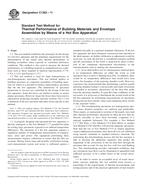
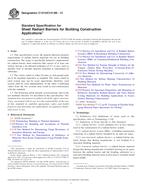 ASTM C1313/C1313M-13..
ASTM C1313/C1313M-13..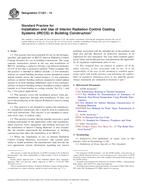 ASTM C1321-14
ASTM C1321-14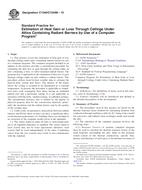 ASTM C1340/C1340M-10..
ASTM C1340/C1340M-10..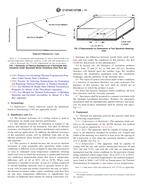 ASTM C1373/C1373M-11..
ASTM C1373/C1373M-11..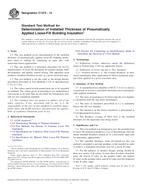 ASTM C1374-14
ASTM C1374-14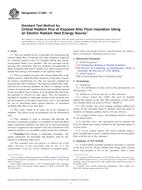 ASTM C1485-13
ASTM C1485-13
 Cookies
Cookies
